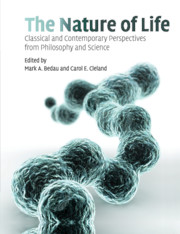Book contents
- Frontmatter
- Contents
- Preface
- Acknowledgments
- Sources
- About the authors
- Introduction
- SECTION I CLASSICAL DISCUSSIONS OF LIFE
- SECTION II THE ORIGIN AND EXTENT OF NATURAL LIFE
- SECTION III ARTIFICIAL LIFE AND SYNTHETIC BIOLOGY
- 16 Learning from functionalism: prospects for strong artificial life
- 17 Life, “artificial life,” and scientific explanation
- 18 Alien life: how would we know?
- 19 Automatic design and manufacture of robotic life forms
- 20 A giant step towards artificial life?
- 21 Approaches to semi-synthetic minimal cells: a review
- 22 Creating “real life”
- SECTION IV DEFINING AND EXPLAINING LIFE
- Supplementary bibliography on life
- Index
- References
20 - A giant step towards artificial life?
Published online by Cambridge University Press: 10 November 2010
- Frontmatter
- Contents
- Preface
- Acknowledgments
- Sources
- About the authors
- Introduction
- SECTION I CLASSICAL DISCUSSIONS OF LIFE
- SECTION II THE ORIGIN AND EXTENT OF NATURAL LIFE
- SECTION III ARTIFICIAL LIFE AND SYNTHETIC BIOLOGY
- 16 Learning from functionalism: prospects for strong artificial life
- 17 Life, “artificial life,” and scientific explanation
- 18 Alien life: how would we know?
- 19 Automatic design and manufacture of robotic life forms
- 20 A giant step towards artificial life?
- 21 Approaches to semi-synthetic minimal cells: a review
- 22 Creating “real life”
- SECTION IV DEFINING AND EXPLAINING LIFE
- Supplementary bibliography on life
- Index
- References
Summary
Step by step, the components of an artificial form of cellular life are being assembled by researchers. Lipid vesicles the size of small bacteria can be prepared and under certain conditions are able to grow and divide, then grow again. Polymerase enzymes encapsulated in the vesicles can synthesize RNA from externally added substrates. Most recently, the entire translation apparatus, including ribosomes, has been captured in vesicles. Substantial amounts of proteins were produced, including green fluorescent protein used as a marker for protein synthesis. Can we now assemble a living cell? Not quite yet because no one has produced a polymerase that can be reproduced along with growth of the other molecular components required by life. But we are closer than ever before.
INTRODUCTION
Evidence from phylogenetic analysis suggests that microorganisms resembling today's bacteria were the first forms of cellular life. Fossilized traces of their existence have been found in Australian rocks at least 3.5 billion years old, and isotopic signatures from Greenland suggest that life might have existed even earlier, around 3.8 billion years ago. In the time since life's beginnings, the machinery of life has become advanced. For instance, when researchers knocked out genes in one of the simplest known bacterial species, they reached a limit of ~265–350 genes that appear to be an absolute requirement for contemporary microbial cells.
- Type
- Chapter
- Information
- The Nature of LifeClassical and Contemporary Perspectives from Philosophy and Science, pp. 268 - 271Publisher: Cambridge University PressPrint publication year: 2010

